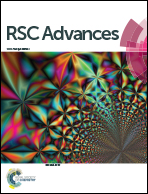Design, synthesis and anticancer activity of furochromone and benzofuran derivatives targeting VEGFR-2 tyrosine kinase†
Abstract
In continuation of our work concerning the relation between the anticancer and anti-vascular endothelial growth factor receptor (anti-VEGFR-2) activity of some synthesized compounds, we hereby designed and prepared three new series of furochromone and benzofuran derivatives (carbonitriles, sulfonyl hydrazides and imides). The prepared compounds were evaluated for their in vitro VEGFR-2 inhibitory activity, their cytotoxicity on fifteen human cancer cell lines and their in vivo antiprostate cancer activity. The highest anti-VEGFR-2 activity was demonstrated by 6-acetyl-4-methoxy-7-methyl-5H-furo[3,2-g]chromen-5-one (3), which exhibited the same IC50 value as the reference drug sorafenib (2.00 × 10−3 μM). On the other hand, most of the synthesized compounds showed potent cytotoxicity against most of the tested cell lines, in particular, the carbonitrile series (4a,b and 5a,d) which exhibited the best activity with IC50 values ranging from 3.56 × 10−13 to 4.89 × 10−7 μM. Moreover, the imide series (15–17) showed the most significant in vivo antiprostate cancer activity. An in silico GOLD molecular docking study has been done to explore the binding mode of interaction of the furochromone and benzofuran derivatives to VEGFR-2 kinase, and to reveal the correlation between IC50 (μM) of the enzymatic inhibition of VEGFR-2 kinase and the GoldScore fitness for further therapeutic application.


 Please wait while we load your content...
Please wait while we load your content...